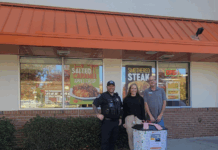
Level Grove Road will reopen Nov. 24, right before Thanksgiving “without fail,” according to Cornelia City Manager Dee Anderson. The road closed in mid-July to install sidewalks and a new sewer main, and was scheduled to take three to four weeks, but has been closed ever since.
Citizens have grown increasingly frustrated with its closure. Level Grove is a major road for Cornelia residents and businesses, connecting Cornelia’s historic downtown to the rest of the city, and the road work has been a problem for the residents of the homes and apartments right by the worksite.
The month-long project has spanned over four months due to complications under the road’s surface. The contractor working on the project found several water and sewer lines under the road that the city was unaware of and needed to investigate.
While it might seem strange that the city uncovered water and sewer lines it didn’t know about, finding unmapped water and sewer lines in Cornelia isn’t unheard of, it’s actually a fairly common occurrence.
“We have found where we’ve cut a [water] line here, and four streets down, two houses were out of water from where years ago they [city officials] had run a water line,” City Manager Anderson says. “Before other houses were built, they would just run water lines across property instead of following the streets. Nothing’s on a map, it was in somebody’s head, whoever worked here at the time and did it. I guess there used to be this belief that people were going to be here forever.”

Anderson says that old, unmapped lines have been found underneath homes and businesses, and the city has responded to situations where old sewer lines backed up and leaked into buildings.
“It’s just an ongoing thing, and I’m sure we’re not unique in that any of these older cities are going to be that way,” he says. “That’s why a lot of cities have such old infrastructure is the belief that once it goes in the ground, you really didn’t have ever have to worry about it.”
There’s a plan to fix this problem, though. Over the next five years, the city plans to have all of its old water and sewer lines replaced. During his time with the city, Anderson estimates the city has replaced about 90 percent of their water lines, and that sewer lines are the next big undertaking. He says that every time they replace old lines, or discover unmapped lines, they’re added to the city’s Geographic Information System (GIS) to keep records of infrastructure locations.
He says that while the city will have a much better understanding of its water and sewer lines, there “may always be something that’s under somebody’s house.”






